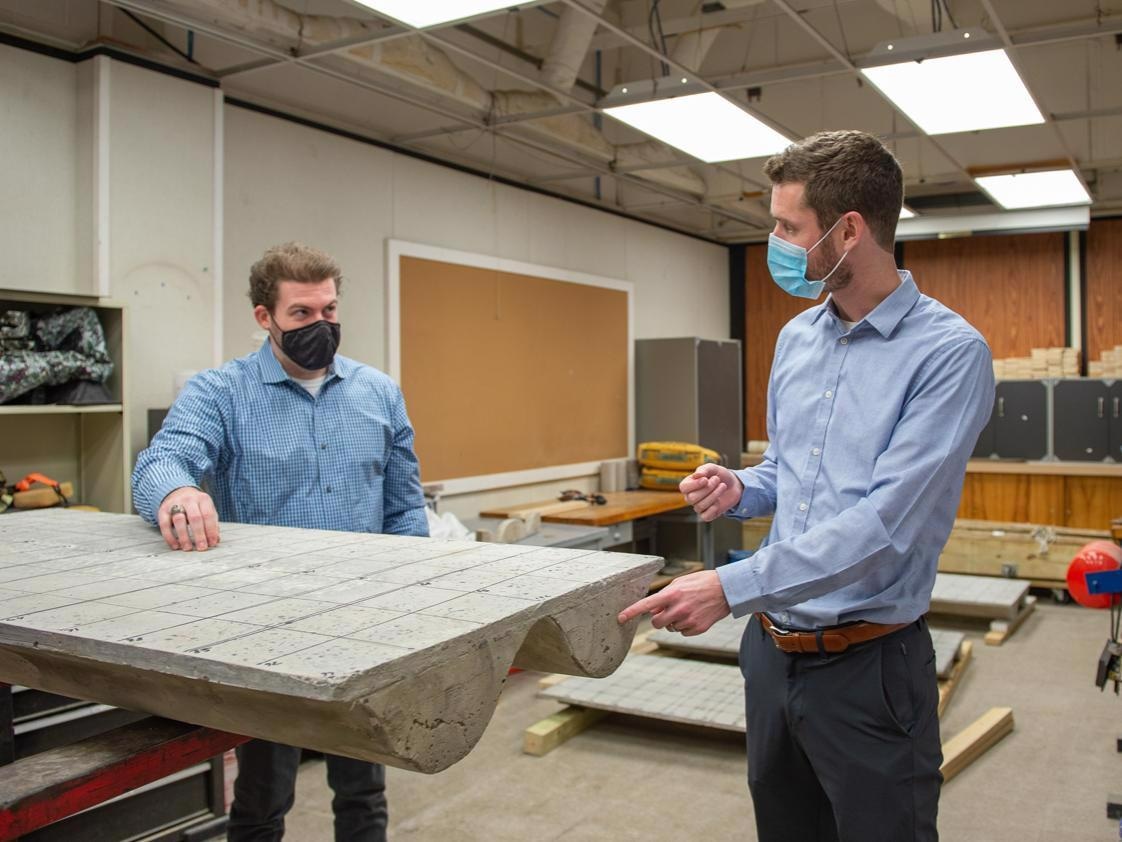Feb 3 2022Reviewed by Alex Smith
A practical strategy for enhancing sustainability in buildings is using less material in floors, as it can decrease the environmental footprint of the structure.
 Penn State researchers investigated a method for better balancing sustainability with desirable acoustic properties in concrete floor slabs similar to the one shown in this photo with, left, Jonathan Broyles, an architectural engineering doctoral candidate, and Nathan Brown, assistant professor of architectural engineering. This scaled-down slab, fabricated in collaboration with Jonathan C. Boliek, an independent contractor, is a model for future research with Micah Shepherd, assistant research professor of acoustics and a paper co-author. Image Credit: Kelby Hochreither.
Penn State researchers investigated a method for better balancing sustainability with desirable acoustic properties in concrete floor slabs similar to the one shown in this photo with, left, Jonathan Broyles, an architectural engineering doctoral candidate, and Nathan Brown, assistant professor of architectural engineering. This scaled-down slab, fabricated in collaboration with Jonathan C. Boliek, an independent contractor, is a model for future research with Micah Shepherd, assistant research professor of acoustics and a paper co-author. Image Credit: Kelby Hochreither.
Selecting only this goal, however, can result in undesirable effects—such as noise traveling between floors or an echo in a room, according to Nathan Brown, assistant professor of architectural engineering.
Researchers at Penn State University (PSU) explored a technique for enhancing the structural and acoustic properties of concrete floor slabs. Their findings have been reported online ahead of the March print edition of the Journal of Architectural Engineering.
The exciting result of our research is that shaped structures can improve sound insulation performance in buildings while reducing the embodied carbon emissions of the structural system.
Jonathan Broyles, Study First Author and Architectural Engineering Doctoral Candidate, Penn State University
To start their exploration, the team used 3D modeling software to develop shaped concrete slabs composed of many curves linked by movable control points. By giving the program parameters to follow when shifting these points, the team allowed the software to create a range of probable designs with realistic, tailored constraints.
Continuing the effort to discover a promising design—a process known as optimization—the researchers wanted to test the performance of the created designs in two areas. They examined structural properties, for complying with building engineering standards, and acoustic properties, for reducing unwanted sounds.
Traditional optimization is focused on targeting one value as a good or bad design, but in this case, we have two values: one to evaluate structural performance and another for acoustic performance. We set up a model with some variables and used a computer algorithm to move through potential designs, targeting better options for both values at the same time.
Dr Nathan Brown, Study Corresponding Author and Assistant Professor of Architectural Engineering, Penn State University
The researchers used several equations to inform their optimization limitations. Besides considering mass, with a goal of decreasing mass to lower the emissions necessary to make and install a slab, the team also took into consideration shape and stiffness.
According to Brown, comprehending the influence of each of these variables on acoustic properties would help the researchers to decrease the power of transmitted sound waves hitting the slab.
Using optimization, the team could identify concrete slab designs that used less concrete than a conventionally designed slab and maintained necessary acoustic properties. These results, Brown said, form the basis of the design of shaped concrete floors that can be enhanced for better interaction with sound without sacrificing sustainability.
Broyles said the study was driven in part by his interdisciplinary interests.
I came to Penn State to pursue research at the intersection of structural engineering and acoustic design. After I met with Dr. Brown, I realized that this topic could be explored in optimization studies of shaped concrete floors to help understand the relationship between sustainability and building acoustics.
Jonathan Broyles, Study First Author and Architectural Engineering Doctoral Candidate, Penn State University
The researchers plan to apply the approaches used in this study to comprehend the trade-offs between sustainability and performance in areas outside of acoustics. According to Brown, investigating this connection can pave the way to more sustainable buildings that do not sacrifice the quality of life.
“This is what’s interesting to me about the design process—especially for building components that have to do many different things and achieve many quantitative performance targets while still possessing qualitative traits that make buildings places we want to dwell in,” Brown said. “A lot of my core research agenda lies in considering these quantitative objectives we can measure while still giving designers freedom and flexibility to think about those qualitative aspects.”
Micah Shepherd, assistant research professor of acoustics at PSU, also contributed to this study.
Journal Reference:
Broyles, J. M., et al. (2021) Design Optimization of Structural–Acoustic Spanning Concrete Elements in Buildings. Journal of Architectural Engineering. doi.org/10.1061/(ASCE)AE.1943-5568.0000520.
Source: https://www.psu.edu